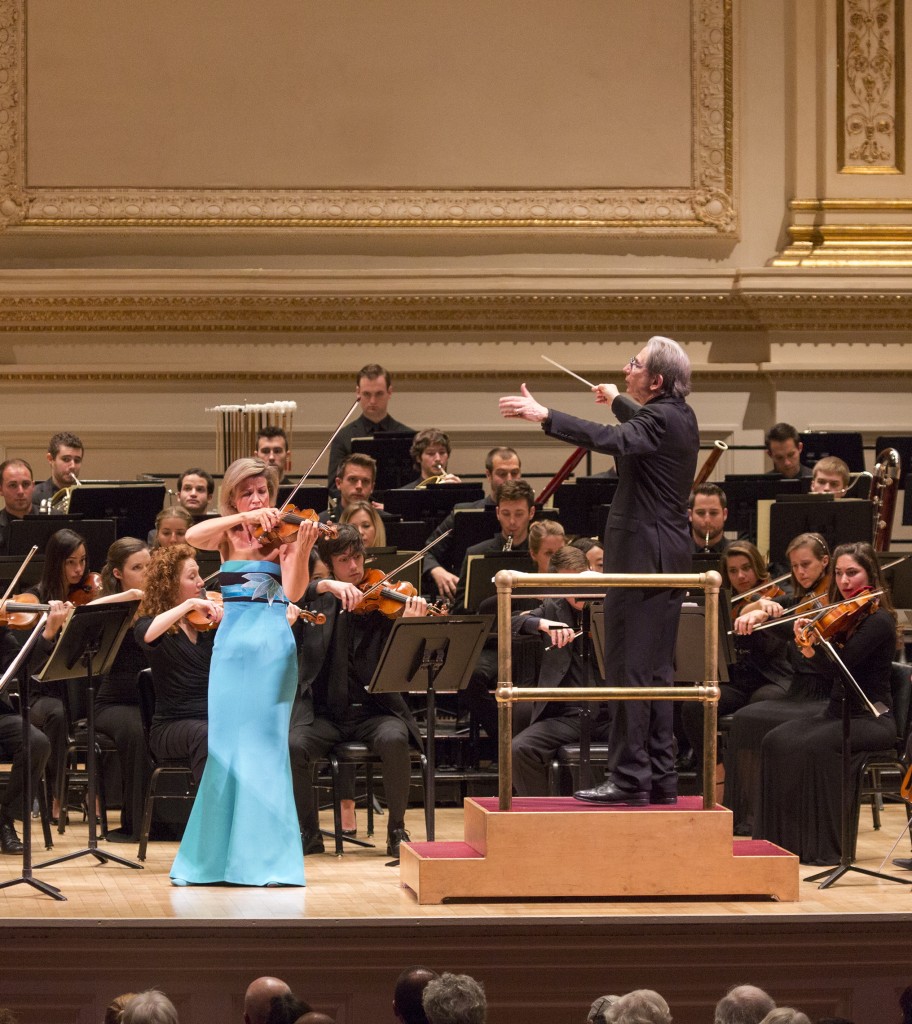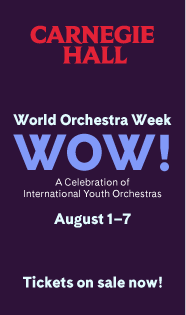Mutter, Tilson Thomas and New World Symphony unforgettable on one of Carnegie’s great nights

Anne-Sophie Mutter performs with Michael Tilson Thomas and the New World Symphony Tuesday night at Carnegie Hall. Photo: Richard Termine
Tuesday night was a great night of music at Carnegie Hall.
The concert by the New World Symphony, with conductor and artistic director Michael Tilson Thomas, was the last of this season’s Perspective Series for violinist Anne-Sophie Mutter, who soloed in front of the orchestra not once, but twice. The pleasure of hearing this tremendous musician play two of the finest violin concertos of the 20th century was equalled by the pleasure of hearing Tilson Thomas’ great orchestra.
Mutter’s artistry is peerless, and hearing her in person constantly impresses how fine and rare is her musicianship. Her technique is impeccable, and while in other musicians the ability to play fast and clean is notable and often an end in itself, with Mutter, that falls by the wayside. Her technique is so strong that once one realizes how easy she makes the most difficult music sound, it no longer registers, becoming merely a tool for her wise and imaginative expression. It has been a special experience to hear her play the Sibelius concerto back in February, and Tuesday night she played Alban Berg’s sublime Violin Concerto, along with Norbert Moret’s En réve, a terrific piece that the composer wrote for Mutter.
The two pieces communicated, through Mutter, across the generations. Berg’s sits in a space of haunted memory—it is a reaction to the tragic death of a young family friend, but is also a piece where Berg gazes wistfully at the past musics of Bach and Mahler, while pondering the limits of Schoenberg’s 12-tone system.
Moret’s work, which dates from 1998, has the advantage of history and the accumulation of ideas about instrumental technique and form. But the mood and sonorities are but one step beyond Berg, and Moret uses a favorite device from the earlier piece, that of the soloist plucking notes with the left hand while playing a sustained pitch via the bow.
Mutter is the finest contemporary interpreter of both pieces. She has total command of Berg’s concerto, and can then choose to lose herself inside the music. Her sound was constantly beautiful and constantly changing in color and timbre, from silver in the opening arpeggios to a woody quality in the slow, terraced expansion of dynamics in the second movement—Tilson Thomas shaped this, level by level, with mastery. With her sense of line that went all the way through each phrase, Mutter sounded like she was speaking to the audience in complete sentences, alternately anguished and mystical. Her final E-string trill that ends the piece sounded like the singing of a soprano.
And always, there was her expressive presence, and through her that of the music. Even when playing with a deliberate reticence, or a driving through a long, convoluted line, Mutter made Berg’s complex, mysterious psychology vivid. The orchestral accompaniment was superb, with a large-scale shape across the two movements that felt completely right and satisfying. Violist Hannah Nicholas’s solo line that elided off the end of one of Mutter’s phrases was exceptional.
Moret’s piece, making its belated New York premiere, can be described as sounding like the music Moret dreamt of during the night after listening to Berg’s concerto. The Berg concerto is an internal expression made public, Moret’s goes deeper into the weird, disjointed experience of the innermost mind. His writing exploits Mutter’s gift for colors, and pulls sounds out of the violin that range from the dazzling—an opening of fast arpeggios played in harmonics—to the impossible—a kind of muttering, vocalized wah-wah sound, which is strange yet beautiful. En réve is a dream, and there is substantial amount of romanticSox should feel right at home playing in front of no fans.ism haunting it, but it also has the post-modern form of rapid cuts and juxtapositions between events.
As for the New World Symphony, they are a great orchestra, certainly on this night. The concert opened with Schubert’s Incidental Music to Rosamunde, and closed with Debussy’s La Mer. No orchestra in Carnegie Hall over the past few years has sounded better than this one, and few have sounded as good. This is of course a training orchestra, where post-graduate musicians spend three years before moving on to professional gigs.
Certainly, young musicians these days have technical refinement in spades, but this group goes beyond. They have an unusual fullness and weight, and somehow manage to produce such width and depth of sound that sections like the woodwinds are widely separated by space and air, even as they don’t appear distant. Carnegie Hall is the same dimension for every orchestra, yet last night it felt tripled in size.
The Rosamunde music was unusually dark, slow and subdued through much of the first movement, but that turned out to be Tilson Thomas’ long-term plan to shape the large-scale form and tension of the music. The woodwinds, especially in the second movement, sounded ideal for Schubert, bright and throaty. There was grace and energy throughout.
La Mer was powerful and exciting, eschewing gauzy impressionism for clarity, exactitude, and muscle. Tilson Thomas skillfully managed subtle and extremely effective tempo modulations. Some of the rolling woodwind phrases and brass harmonies in the first movement were held consistently behind the phrasing of the rest of the orchestra, which is difficult to do and proved musically sensational. Balances throughout were excellent, and the tremendous, swinging pulse and momentum that the musicians produced in the last movement was capped by some of the most gorgeous low brass playing one will ever hear.
For an encore, the group played the Farandole from Bizet’s L’Arlésienne, and the obvious pleasure of the musicians left the crowd begging for more. But the musicians had a plane to catch.

Posted May 01, 2015 at 9:15 am by Ellen Fleysher
This review is simply spectacular! I saw this concert in the New World Symphony’s home concert hall in Miami Beach and relived the experience reading this account. Thank you. In its 25 years, the New World Symphony has sent on more than 900 musicians into the world’s leading orchestras. It is always a thrilling experience to hear them under MTT’s baton or many of the stellar guest conductors who regularly lead them. The young musicians who compose NWS are devoted and breathtakingly talented.